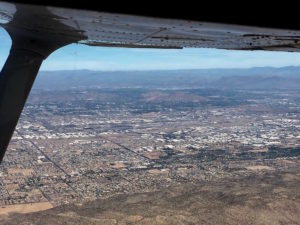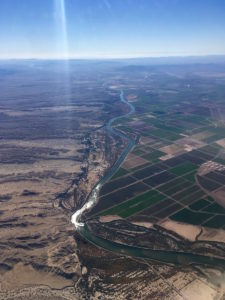A solo diversion
December 25th, 2017 at 4:18 pm (Flying)
My return from Phoenix to L.A. was a little more eventful than my trip out.
I departed the Mesa Gateway airport at 12:30 p.m. with an intersection takeoff from runway 30L. I was busy for a while as I climbed to get above KCHD (Chandler)’s airspace (which goes up to 3000′) but stay below the Phoenix Bravo (starts at 4000′). I contacted Phoenix Departure and got flight following, plus a bonus clearance into the Bravo without even asking! That simplified my route quite a bit.

Inside the Phoenix Bravo!
 Most of the flight back (cruising at 8500′) was uneventful. I played around with the GPS some more. I read the map. I updated my nav log. I scanned my instruments. I crossed the Colorado river.
Most of the flight back (cruising at 8500′) was uneventful. I played around with the GPS some more. I read the map. I updated my nav log. I scanned my instruments. I crossed the Colorado river.
From my weather briefing that morning, I knew that there were some low-visibility areas in the L.A. basin – which often arises from the marine layer, which burns off by midday or early afternoon, and usually it doesn’t extend as far east as El Monte anyway. However, just in case, I had backup plans.
Three hours after departing, I entered the L.A. basin, where I discovered a soupy haze starting around Ontario. Yuck! The SoCal controller told me to report when I had (weather) information Foxtrot from EMT. The news wasn’t great; EMT was reporting 3 statute miles visibility. So there I was (over PDZ), flying about 100 mph towards a destination that was dicey. Three miles visibility is (barely) legal for VFR flight, but it is considered “marginal”, which is not a good thing. Rick Durden, in his excellent The Thinking Pilot’s Flight Manual, quoted Terri Watson saying,
“Anything to do with marginal weather means the pilot has to understand deep inside that she or he is entering a statistically significant realm where he or she is likely to wreck an airplane and kill or injure people.”
I also couldn’t help remembering a conversation I’d had with my mom that morning when I explained what “personal minimums” are. My personal minimum for daytime VFR is 5 miles visibility. And yet… even so… for a brief moment I was tempted to push onward to EMT. The drive to continue your planned flight is very powerful!
Information Foxtrot from EMT was 45 minutes out of date. I asked the SoCal controller if there was any update. I think he called the tower directly for me. He came back a few seconds later and said they still said 3 sm vis. I took a breath and said I would divert to POC. I had checked their ATIS too, and despite being only 10 miles from EMT, they were reporting 10 sm vis (better conditions than CNO as well).
I headed straight there, cutting through Ontario’s airspace. I don’t have any more pictures as I was busy flying the plane. :) As I approached POC, conditions seemed worse to me than 10 sm vis, but way better than 3 sm vis. Thank goodness I was familiar with the area, although I’d never approached POC from the southeast. I got cleared for a left base to runway 26L and spotted the traffic ahead of me. Then on final they told me to switch to 26R to allow an IFR departure. 26R is shorter, but I’ve landed there before so I went ahead and sidestepped to the right. (Had I not felt good about that, I could have said “unable” and presumably they would have worked around it or told me to go around).
After landing, I took a minute to collect myself. I definitely was feeling the increased mental effort from the diversion, the low visibility, and the last-minute change in assigned runways. But I made it on the ground, safe and sound! I taxied over to the transient parking area and shut down and tied up the plane. I went in, took a break, checked the weather, and called for fuel.
By the next time the weather reports updated, EMT was reporting 7 miles visibility, so I went for it. I got the plane ready, only to then discover that POC was now reporting 3 sm vis! It didn’t appear to be noticeably worse than when I’d landed, and I knew that I should be heading towards improving conditions, and also that if I took off and didn’t like it, I could turn around and land again. So I decided to proceed.
After takeoff, I climbed to 2500′, which was above the haze (nice!). However, the ground wasn’t easy to see. Once again, familiarity with the area was a boon. I transferred to the EMT tower and spotted traffic they called off my right. As I came around to final I noticed that the PAPI (glideslope light) wasn’t there! No matter, I don’t need it to land, especially at EMT. Touching down that afternoon was my 500th landing, and it was an excellent one!
Overall, it was a good experience that made me work a little harder than is typical in sunny southern California. (With conditions like that, I probably wouldn’t have bothered to go flying for fun.) Here are my reflections:
- It’s possible that I could have made it fine to EMT on the first try, but it’s also possible that I could have ended up in deteriorating conditions, disoriented, or worse. The fact that weather reports come out only once an hour is pretty limiting. (They can be updated more frequently, but you cannot depend on that.) I’m glad that I opted to divert. I’ve wondered if I would have the strength to resist get-there-itis if I were solo and needed to make that judgment call.
- Personal minimums are VERY useful. The whole point is that you’ve thought about your comfort zones and skill levels in advance, so that in the moment you don’t waste time trying to assess risks and (most likely) rationalize a potentially dangerous decision. Arguably, my second takeoff was less well advised, but I’d had time to think it through on the ground, and I felt good about the decision.
- POC is a great alternate destination for EMT if there’s some reason that EMT is unavailable or closed. It is not really a great weather alternate since the two airports are so close together and therefore likely have similar weather. It worked out well for me in this case, but a safer bet would have been Riverside or San Bernardino. Since I was coming from the east, I knew conditions were better the farther east I landed. But farther east would be progressively more inconvenient, and I definitely felt the pressure of wanting to get closer to my destination if possible!
- My ongoing project of landing at all of the L.A. airports has real utility! Having visited other airports makes it that much easier to confidently divert to them even if they were not your intended destination. Banning, Flabob, Chino, and Corona were all additional options that I had previously visited.
- It really is true that when things pile up, even if each one isn’t a big deal, just mentally dealing with a longer list (plus uncertainty) is fatiguing and that in itself is a risk factor. When I took off the second time, I was refreshed (and my plane had full tanks). I felt much more sharp and capable, and I had plenty of options if needed.
- Yes, I reported that the PAPI was out after I landed at EMT. Another pilot on the ground chimed in to confirm, so it was good to hear that I wasn’t imagining things. ;) (And EMT was able to send someone out to check it.)
Next adventure? Bring it on!